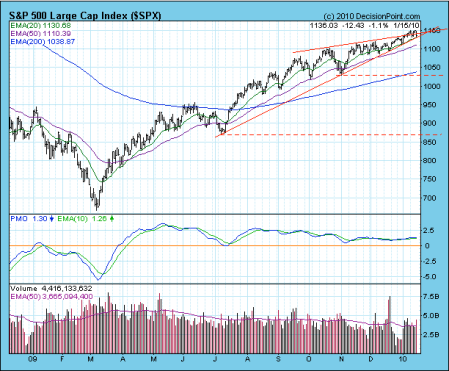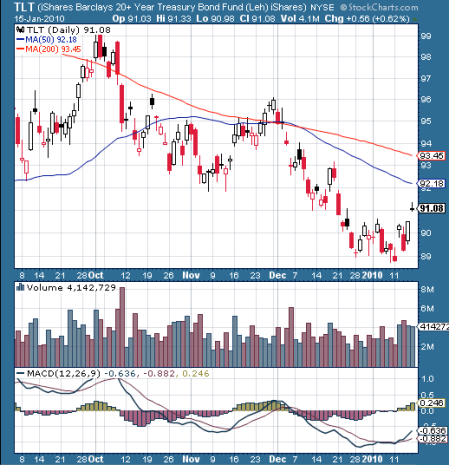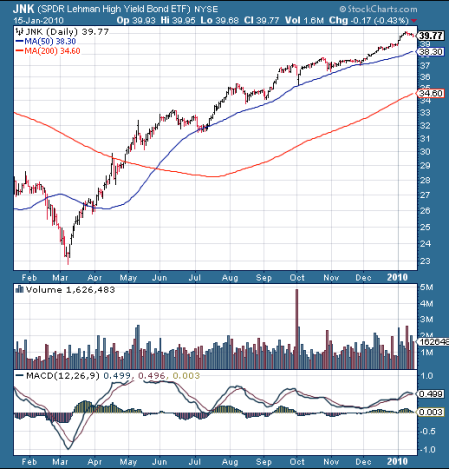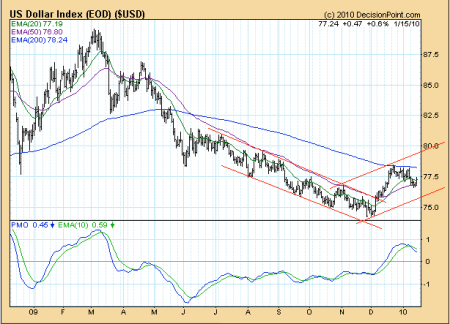SPX – 1136.03
DJIA – 10,609
January 19, 2010
“This will be a transitional year. I am not sure how it will end for the markets. Cyclical forces are bullish. Governments and central banks have poured money into the global economy. We don’t know what the true condition of the economy would be without all that help.”
-Felix Zulauf, Barron’s, January 18, 2010
The S&P 500’s pattern from its November 3 low (1029.38) is one of sharp, short-lived pullbacks to its rising trendline and then grinding higher. Will the pattern change? Yes, at some point and perhaps now, but let’s not forget that part of the stock market’s job description includes keeping today’s mix of low-conviction bulls and unremitting bears off guard.
The first indication to me that a correction might be underway would be a confirmed break of the trendline (connecting the July and November lows) the SPX is hugging; it’s well tested so a break should be more valid than not. For confirmation, I want to see two consecutive days of the SPX’s body (using candlestick charts) closing below the trendline, which would also be under its 20-day moving average.
For now, the Market Trend Indicator (MTI) is signaling Uptrend. This rating stays in effect until one or more of the MTI’s thee key indices closes below its respective 18% weekly exponential average. The SPX’s 18% average is 1110.55 this week and the DJIA’s is 10,380. The New York Advance/Decline line is 6,536 net advances above its 18% average. Net volume is in synch with the MTI; peak readings that would have to be overbalanced to indicate a change in trend are +47.0 for the NYSE and +48.4 for NASDAQ.
Recent market action including weekly net volume reconfirming the uptrend and an upturn in the SPX’s annual swing chart reinforce my sense that once selling follows through, it’s likely only a correction in a cyclical bull market to be followed by higher prices later in 2010. However, that’s bias and shouldn’t impact taking action when a signal is given. I’m counting the rally from November as the third section. The rule is to count three sections and expect a fourth. After a three-section advance, if price and time were to overbalance (surpassing all declines since the March low in price and time) for the SPX, it would indicate a cyclical bear market underway. I’m not in the secular bear camp.
Harmonic Preview:
(High Probability SPX Turning Point or Acceleration Days)
January 20* (Wednesday)
January 21* (Thursday)
January 27 (Wednesday)
February 1* (Monday)
*An asterisk denotes a dynamic SPX price square in time; different factors account for the other dates.
As for groups, here are the top ten and bottom ten groups as ranked by relative strength among the 100 groups I monitor. If a correction starts, I’ll compare this list to the rankings when the decline is over. Group action tells its own story. If a group rises further than the averages in an advance and goes down less than the averages in a decline, it speaks to something being right and vice versa for underperforming groups. That said, there’s no indication yet that the action favoring a “buy low-sell high” methodology in this market over a “buy high-sell higher” relative strength approach has changed.
Top Ten Groups Bottom Ten Groups
Airlines Insurance Brokers
Automobiles Gold Mining
Steel Food Retailers/Wholesalers
Coal Distillers/Brewers
Aluminum Personal Products
Business Training & Employment Integrated Oil & Gas
Platinum & Precious Metals Nondurable Household Products
Real Estate Holdings/Developers Soft Drinks
Home Construction Property & Casualty Insurers
If the overall market starts to correct, I expect cyclical leaders to come under pressure as fears of a “double dip” recession mount and institutional money shifts to more defensive groups, including some in the bottom ten list. New exchange traded funds (ETFs) that started trading last week include ETFS Platinum Trust (PPLT), ETFS Palladium Trust (PALL) and Global X China Materials (CHIM). The bullish fundamentals in the markets tracked by these ETFs are likely secular but the near-term popularity as highlighted by new ETF trading warns me to prepare for near-term weakness.
In other markets, long-term government bonds appear poised for a counter-trend rally. I use TLT as a proxy; it only spent one day below the trendline connecting the lows in June 2008 and June 2009 and could rally to its 200-day moving average with the help of “flight-to-safety” buying. The spread between high quality and junk bonds peaked at year-end 2008 and has shrunk since, including seven weeks in a row until widening a tad last week as companies raised a record $11.7 billion in the high-yield bond market.
The U.S. Dollar index looks to me like it could rally further in the near-term and if so, I suspect that sets up the next buying opportunity in gold. The ideal for me would be a gold price below its December 30 low (1087.50 2nd London fix) followed by a rally and close above its 50-day moving average to indicate the dip has passed. If the markets start to discount the possibility a “double dip,” I think it helps stock market liquidity as it eases the pressure on the Federal Reserve to speed up its exit strategy.
The International Energy Agency expects oil demand of 86.3 million barrels a day in 2010, up 1.4 million barrels a day from 2009 (first decline since 1983) and just below the record 86.5 million barrels a day in 2007. Oil demand may have peaked in developed countries but growing demand in emerging markets and the Middle East is more than making up the slack.
California is the largest American exporter to China by state. Computers and electronics are the lead category and number two is waste and scrap. Standard & Poor’s lowered its rating on California’s general obligation bonds to A- from A. I expect both gambling and marijuana to be legalized here in the Golden State to deal with budget problems.
Chubbybrain reported that venture capitalists funded 687 companies with $5.5 billion in the fourth quarter. Internet-related deals accounted for nearly $1.5 billion spread among 227 companies, with average funding of nearly $6.6 million and median funding of $3.4 million. The largest deal was a $180 million round C into Zyngo, a social game company.
Conclusion:
Technical evidence indicates it’s late in the day. The S&P 500’s high was recorded just last Thursday, but the five-day moving average of advancing volume was particularly light. The SPX’s weekly swing chart is in its thirteenth swing; Jerry Favors used to call a pattern with 13-15 swings the “death zone.” If the SPX’s body (using candlestick charts) is below its rising trendline (connecting the July and November lows) for two consecutive days, it would be a leading signal that the intermediate-term advance is likely over. My recommended level for trailing stop sell orders tied to the SPX is just below the December 18 low (1093.38).
When the trend reverses, I believe some of the best shorts are likely ETFs tied to cyclical groups or small cap indices. I know the rules call for shorting weak groups but given the contrary nature of the advance, institutions forced to stay fully invested are likely to seek safety in defensive groups. I think larger profits can be made catching the turn in currently strong indexes and cyclical groups.
Potential short candidates include Russell 2000 iShares (IWM), Russell Microcap iShares (IWC), Real Estate iShares (IYR) and S&P 500 Consumer Discretionary SPDRs (XLY). For more leverage, traders could go long inverse ETFs including ProShares UltraShort Russell 2000 (TWM) and ProShares UltraShort Real Estate (SRS). My follow up for specific recommended stop levels will be limited to the S&P 500.
For investors, I recommend planning ahead as to what percentage of assets to hold in stocks once longer-term technical indicators show the cyclical bull market has run its course. I’ll keep you up to date on that front but those sorts of signals are not close. I also think it makes sense for investors to raise cash if SPX prices were to surpass 1200 in late February/early March.
The information contained herein is based on sources that William Gibson deems to be reliable but is neither all-inclusive nor guaranteed for accuracy by Mr. Gibson and may be incomplete or condensed. The information and its opinions are subject to change without notice and are for general information only. Past performance is not a guide or guarantee of future performance. The information contained in this report may not be published, broadcast, rewritten or otherwise distributed without consent from William Gibson.






